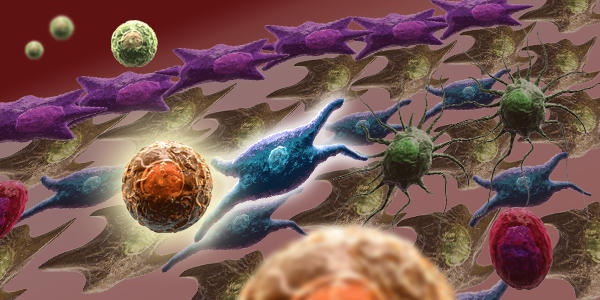
Stromal cells are classically defined as cells than make up the connective tissue of an organ, with their historical role to simply provide the architecture for the support of other functional cells within these organised tissues. However, rapidly emerging evidence suggests that stromal cells are far more deeply involved in the functional regulation of many tissues, organs, and in particular - immune responses.
Non-hematopoietic stromal cells, including fibroblasts, myofibroblasts, endothelial cells, pericytes, smooth muscle cells and mesenchymal stromal cells are now beginning to be appreciated as key cells required for the development and function of the immune system. In addition they are central to the persistence of many cancers and starting to be considered as functional cells in various immune-mediated diseases. They have been shown to present antigen, respond to pathogens, allow immune tolerance, educate functional responses of other immune cells, and to control wound healing. Indeed there are few immunological processes that stromal cells are not deeply involved in!
As this is an emerging field, there is a relative lack of specific markers available to identify the stromal cells of multiple organs. However stromal cells are mesenchymal in origin and committed to a non-hematopoietic lineage, and so can be distinguished from ‘classical’ immune cells by a lack of CD45 expression. Stromal cells can be further separated from non-hematopoietic epithelial cells by a lack of CD326 (EpCAM) expression and in many organs by high expression of CD90 (Thy1).
They produce components of the extracellular matrix (ECM) such as collagens, fibronectin and laminin, and express many matrix metalloproteinases (MMPs), including MMP1, MMP2and MMP9, alongside their endogenous inhibitors - tissue inhibitor of metalloproteinases (TIMP)-1 and TIMP-2. Stromal cells express many adhesion molecules including VCAM-1, ICAM-1, ICAM-2 and ICAM-3 that allow them to interact with immune cells via integrins such as VLA-4. Certain stromal cell populations also express MAdCAM and can interact directly with ECM components by expression of integrin pairs such as the vitronectin receptor CD51/CD61.
References:
Stromal cells within lymph nodes are perhaps the best studied, and multiple stromal subsets with distinct function have now been identified based on expression patterns of Podoplanin, PECAM-1, Lyve-1, MAdCAM and the α7 integrin. The function of stromal cells in the developing lymph node is dependent on Lymphotoxin (LT) signalling, with the LT beta-receptor (LTβR) expressed on stromal cells making them responsive to LTα that is produced mainly by immune cells.
Precise functional responses of stromal cells vary between tissues, but include sensitivity to Transforming Growth Factor (TGF)-β1, Basic Fibroblast Growth Factor (FGF-basic) and Platelet-derived Growth Factor (PDGF), via expression of the PDGF receptor α/β chains CD140a and CD140b.
Many stromal cells associated with cancer express Podoplanin and the expression of this marker has been linked to higher rates of metastases and poor prognosis. In addition, emerging evidence suggests that stromal cells express innate immune receptors such as the Toll-like receptors (TLRs) TLR2, TLR3 and TLR4, indicating that these cells may play previously unappreciated roles in the sensing of invading pathogens.
As is rapidly becoming clear, stromal cells actually perform a wide range of functions within the immune system. Further characterising these fascinating cell populations in health and disease will allow for a far greater understanding of their critical roles in immunity and homeostasis.
References:
Follow Us